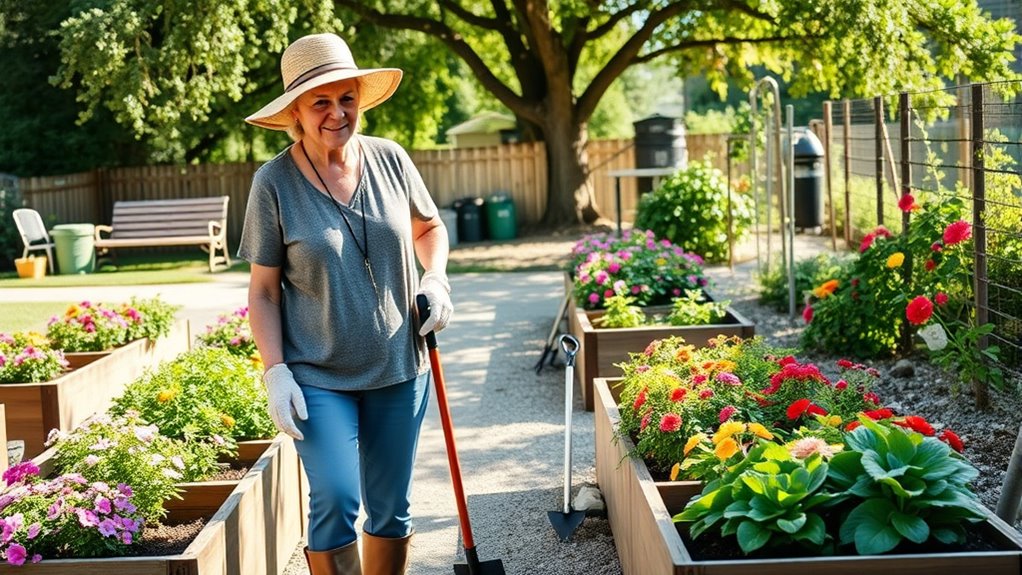To garden safely as a senior, choose ergonomic, lightweight tools and create accessible spaces with raised beds, support rails, and wide pathways for stability. Use proper lifting and bending techniques, maintain good sun protection, stay hydrated, and schedule outdoor tasks during cooler times. Manage pests organically and incorporate aids like gloves and supports to prevent strain. For extensive tips on enjoying your garden safely and comfortably, explore the full guide for expert advice.
Key Takeaways
- Use ergonomic, lightweight tools and raised beds to minimize bending, kneeling, and strain.
- Schedule gardening during cooler times and wear sun protection to prevent heat stress and sun damage.
- Incorporate support rails, supportive footwear, and sturdy seating to enhance stability and prevent falls.
- Practice proper lifting, bending, and reaching techniques to avoid muscle strain and injuries.
- Stay hydrated, apply sunscreen regularly, and recognize signs of dehydration and fatigue for optimal safety.
Choosing the Right Gardening Tools and Equipment
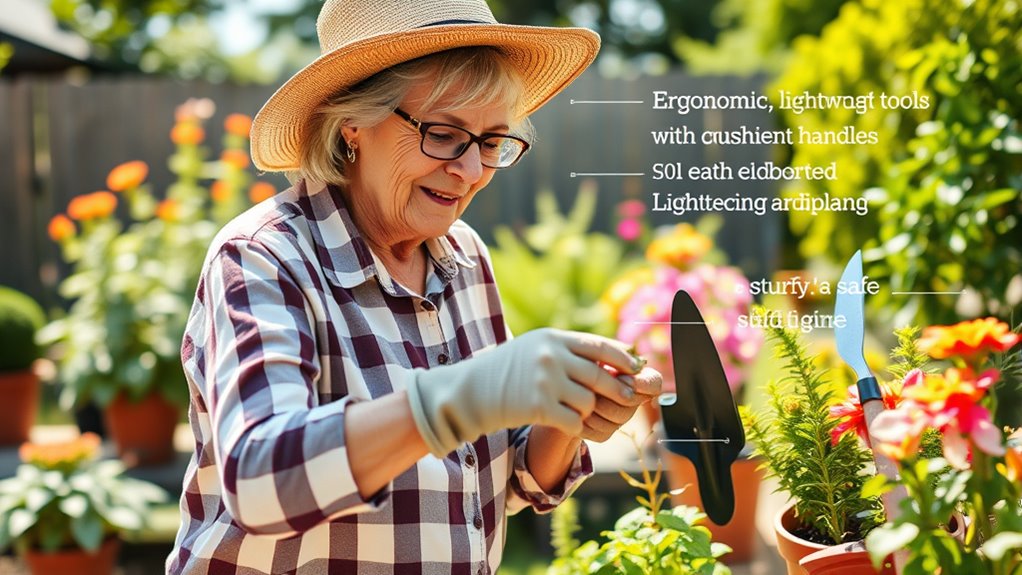
When selecting gardening tools and equipment, it’s vital to prioritize safety and comfort. Ergonomic tools are designed to reduce strain on your hands and wrists, making gardening less tiring and lowering injury risk. Look for tools with padded grips and adjustable features to suit your height and strength. Lightweight equipment helps you maneuver easily without overexertion, especially if you have joint issues or limited strength. Opt for tools made from durable, easy-to-clean materials that won’t add unnecessary weight. Avoid bulky or heavy gear that could cause fatigue or accidents. Your goal is to find tools that fit comfortably in your hands and allow you to work efficiently with minimal effort. Properly chosen equipment makes gardening safer, more enjoyable, and accessible for seniors.
Creating a Comfortable and Accessible Garden Space
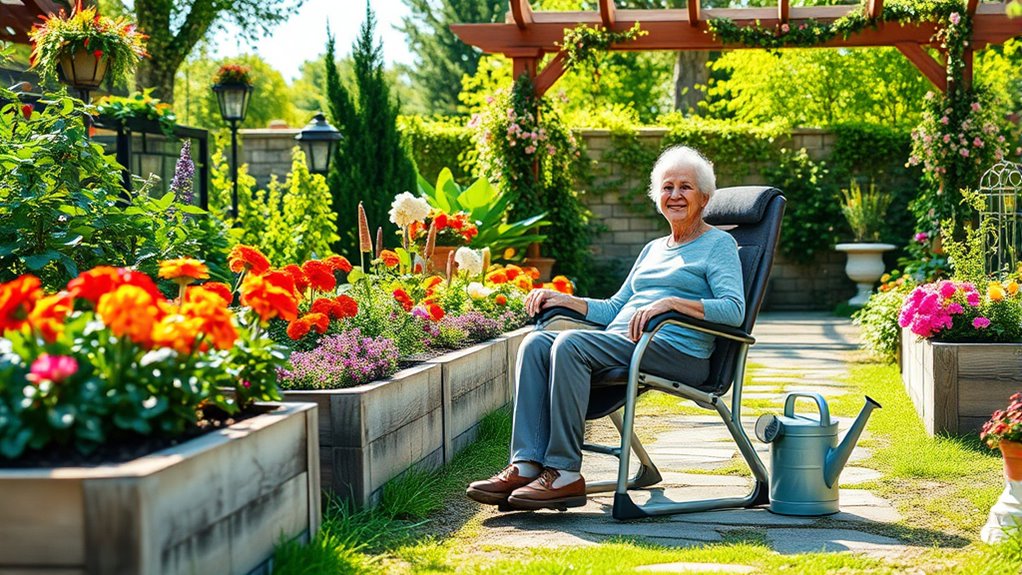
Designing a garden that’s comfortable and accessible can substantially enhance your enjoyment and safety while gardening. Start with a practical garden layout that minimizes walking distances and avoids uneven surfaces. Keep pathways wide enough for mobility aids, such as walkers or wheelchairs. Incorporate seating options like sturdy benches or chairs placed at regular intervals so you can rest frequently. Make certain that seating is comfortable and stable, offering support if needed. Elevate garden beds to waist height or use raised planters, reducing the need to bend or kneel. Use non-slip materials for walkways and ensure good lighting throughout the space. Additionally, selecting self watering plant pots can help maintain consistent moisture levels with less effort, making gardening easier and more manageable. Creating a well-organized, accessible garden encourages independence, reduces fatigue, and makes gardening a safer, more enjoyable activity. Being aware of store hours can help you plan your gardening trips efficiently, ensuring you have all necessary supplies when needed.
Proper Techniques for Lifting, Bending, and Reaching
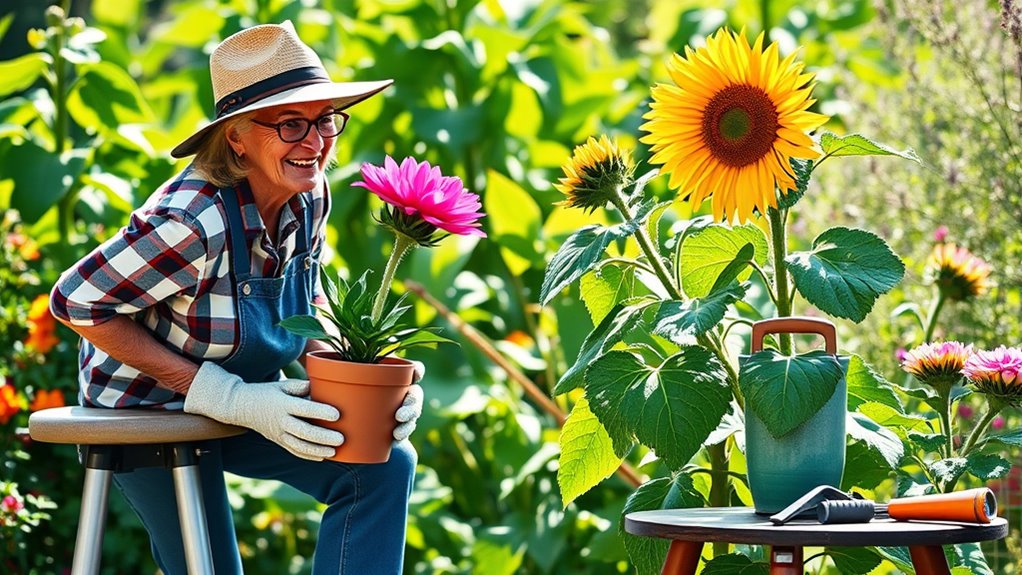
Practicing proper lifting, bending, and reaching techniques helps prevent injuries and makes gardening safer for seniors. Using ergonomic techniques guarantees you minimize strain on your muscles and joints. When lifting, bend at your hips and knees instead of your waist, keeping your back straight and engaging your leg muscles. For reaching, keep objects close to your body to reduce stretch and maintain proper posture. Avoid twisting your torso; instead, pivot your feet to turn. When bending, hinge at your hips rather than your waist, and avoid sudden movements. Regularly adjusting your tools and work height can also help maintain ergonomic comfort. Being aware of trust issues with your partner can help you navigate emotional challenges more effectively. Recognizing relationship compatibility signs can help you foster healthier connections. Incorporating sound healing principles into your gardening breaks can promote relaxation and reduce stress. Additionally, understanding the importance of remote hackathons can inspire you to explore virtual events that foster collaboration and learning, even from a distance. Staying mindful of proper background noise can also help you maintain focus and reduce distractions while gardening. By integrating these proper techniques, you reduce the risk of back pain, strains, and falls, making your gardening experience safer and more enjoyable.
Staying Safe in the Sun and Staying Hydrated
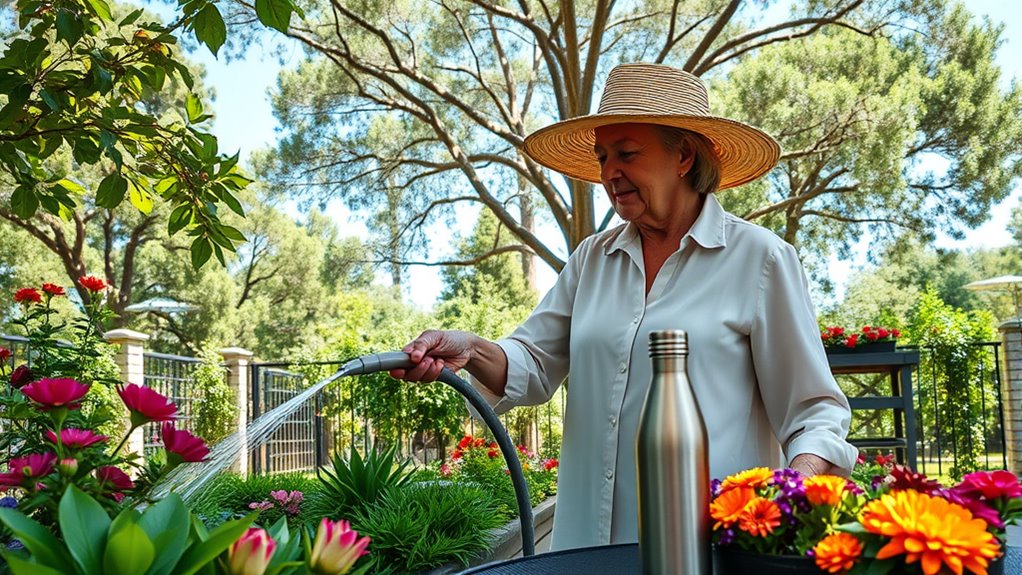
To stay safe while gardening in the sun, you should wear protective clothing and apply sunscreen regularly. Recognize the signs of dehydration, like dizziness or dry mouth, so you can take action early. Planning your gardening sessions during cooler parts of the day helps you avoid overheating and stay comfortable. Incorporating proper hydration techniques can further prevent dehydration and keep you energized. Staying aware of UV exposure and taking steps to minimize it can significantly reduce the risk of sun damage. Being aware of safety measures can help you maintain your boundaries and focus on your well-being while gardening.
Wear Sun Protection
Ever wondered how to stay safe while enjoying the sunshine during your gardening sessions? Wearing sun protection is essential. Start by applying broad-spectrum sunscreen with at least SPF 30 to shield your skin from harmful UV rays. Choose hat styles designed for sun protection, like wide-brimmed hats or caps with neck flaps, to keep your face and neck covered. Sunglasses with UV protection also help protect your eyes from damage. Remember to wear lightweight, breathable clothing that covers your arms and legs for extra defense. Reapply sunscreen every two hours, especially if you’re sweating or after watering plants. Being aware of UV radiation types can help you choose the most effective protection. Using protective clothing made from tightly woven fabrics can further reduce UV exposure. Additionally, staying aware of the benefits of curiosity can motivate you to learn more about safe gardening practices. Learning about the importance of hydration can help you stay alert and healthy during long hours outdoors. Exploring sun safety tips can provide additional strategies to protect yourself effectively. Taking these simple steps helps reduce your risk of sunburn and long-term skin damage, so you can enjoy gardening safely and comfortably.
Recognize Dehydration Signs
Staying aware of the signs of dehydration is essential when spending time in the sun, especially during gardening. Proper hydration monitoring helps prevent serious health issues. Watch for dehydration symptoms such as:
- Feeling extremely thirsty or dry mouth
- Dizziness or lightheadedness
- Dark-colored urine or infrequent urination
These signs indicate you need to drink more fluids. If you notice any of these symptoms, stop gardening, find shade, and hydrate immediately. Recognizing dehydration early keeps you safe and energized. Remember, seniors are more vulnerable to dehydration, so staying vigilant is key. Keep a water bottle nearby and sip regularly, especially on hot days. Staying proactive about hydration ensures your gardening remains enjoyable and safe. Additionally, incorporating hydration strategies like consuming electrolyte drinks can help maintain your fluid balance during extended periods outdoors. Using AI-powered health monitoring devices can also assist in tracking hydration levels effectively.
Plan Gardening Times
Gardening during the hottest parts of the day can increase the risk of dehydration and sun-related health issues. To stay safe, plan your gardening times early in the morning or late in the afternoon when the sun is less intense. Adjust your watering schedules to keep plants healthy without overexerting yourself, especially during peak heat. Keep seasonal planting simple by choosing plants suited for your climate, reducing the need for frequent watering and care. Remember to wear protective clothing, a wide-brimmed hat, and sunscreen during these cooler periods. By timing your gardening sessions wisely, you reduce heat exposure and stay hydrated. Recognizing garden safety tips can help you prevent fatigue and stay energized throughout your gardening activities. Additionally, incorporating glycolic acid products into your routine can improve skin resilience, making it easier to handle sun exposure and environmental stressors.
Managing Pests and Using Organic Alternatives
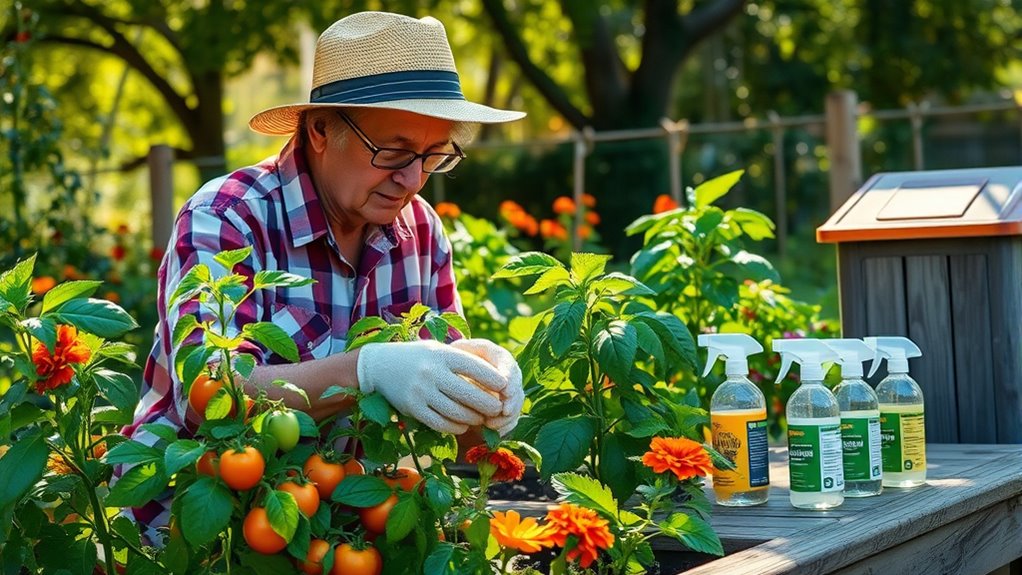
Managing pests in your garden can be challenging, but choosing organic alternatives helps keep your plants healthy without exposing yourself to harmful chemicals. Natural pest control methods and organic pesticide options are effective and safer for seniors. Here are three tips to get started:
Opt for organic pest control methods to protect your garden safely and effectively.
- Use neem oil or insecticidal soaps as organic pesticide options to target pests without chemicals.
- Introduce beneficial insects like ladybugs or lacewings to naturally control aphids and other pests.
- Keep your garden clean by removing dead leaves and debris that can harbor pests.
- Adjusting the angles of your pinball machine can improve gameplay performance and extend the device’s lifespan.
- Incorporate essential oils such as neem or tea tree oil as natural repellents to deter pests safely.
Incorporating Safety Aids and Supportive Devices
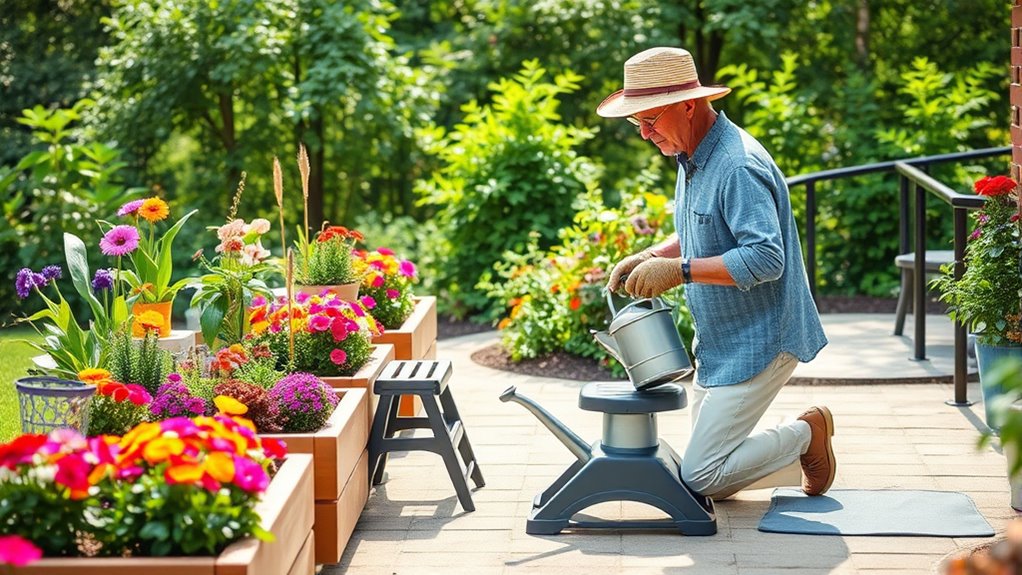
To make gardening safer, you should choose aids that fit your needs and reduce strain. Properly installing supportive devices, like handrails or elevated planters, can help prevent falls and injuries. Taking these steps guarantees your gardening experience remains enjoyable and safe.
Selecting Appropriate Aids
Choosing the right safety aids and supportive devices is essential for maintaining stability and reducing the risk of injury while gardening. To make tasks easier and safer, consider these options:
- Ergonomic tools – designed to reduce strain on joints and muscles, making digging, pruning, and planting more comfortable.
- Adaptive equipment – such as raised garden beds or kneelers with support, which minimize bending and kneeling stress.
- Supportive devices – like lightweight, non-slip gloves and footwear that improve grip and stability on uneven terrain.
Select tools and aids that match your strength and mobility level. Properly chosen ergonomic tools and adaptive equipment can greatly enhance your gardening experience, making it safer and more enjoyable.
Installing Supportive Devices
Installing supportive devices correctly can substantially enhance your safety and comfort while gardening. Start by attaching sturdy support rails along pathways or raised beds to prevent falls and provide stability. These rails offer solid handholds, making it easier to steady yourself when moving around your garden. When selecting tools, look for ergonomic handles designed to reduce strain and improve grip, especially if you have arthritis or limited hand strength. Ensure all devices are securely anchored and positioned at accessible heights to minimize reaching or bending. Proper installation not only reduces the risk of accidents but also encourages independence in gardening activities. Regularly check your support devices for stability and wear, replacing or repairing them as needed for ongoing safety.
Frequently Asked Questions
How Can I Prevent Falls While Gardening on Uneven Ground?
To prevent falls on uneven ground while gardening, wear non-slip footwear to boost stability. Use handrails and supports around garden beds or walkways to steady yourself. Clear the area of loose leaves, stones, or tools that could cause tripping. Take your time, move carefully, and avoid rushing. These steps help you stay safe and enjoy gardening without the risk of falls.
Are There Specific Plants That Are Safer for Senior Gardeners?
You should choose non-toxic plants and low-maintenance greenery to keep your gardening safe. These plants reduce the risk of poisoning if accidentally ingested and require less handling, making gardening easier and safer. Look for options like spider plants, pothos, or succulents, which are generally safe and easy to care for. Picking the right plants helps you enjoy gardening without unnecessary worries about safety or high upkeep.
What Are Signs of Overexertion or Heat Exhaustion During Gardening?
Think of your body as a garden that needs careful tending. When gardening, watch for hydration cues like a dry mouth or dark urine, and fatigue indicators such as dizziness or muscle weakness. These signs are like warning flags waving, telling you to rest and hydrate. Ignoring them risks overexertion or heat exhaustion. Stay vigilant, listen to your body, and take breaks often—your garden’s health depends on it.
How Can I Modify My Garden for Easy Wheelchair Access?
You can make your garden wheelchair-friendly by adding smooth, sturdy wheelchair ramps for easy access to different areas. Incorporate raised beds at waist height, so you don’t have to bend down or kneel, making planting and harvesting simpler. Guarantee pathways are wide and level, with firm, non-slip surfaces. These modifications will help you move comfortably and safely while enjoying gardening activities without unnecessary strain or risk.
What Are the Best Ways to Store Gardening Tools Safely?
Storing your gardening tools safely is like keeping treasures in a secure vault. You should choose secure storage options like sturdy shelves, wall hooks, or lockable cabinets. Proper tool maintenance, such as cleaning and sharpening, extends their life and keeps them protected to handle. Always store sharp or dangerous tools out of children’s reach and make certain everything is organized so you can find what you need quickly and safely.
Conclusion
Gardening is a wonderful activity, especially for seniors, but safety is key. Did you know that falls are the leading cause of injury among older adults? By choosing the right tools, creating accessible spaces, and staying hydrated, you can enjoy gardening while minimizing risks. Incorporate safety aids and follow proper techniques to protect yourself. With these tips, you’ll continue to find joy and health benefits in your garden—safely and comfortably.
